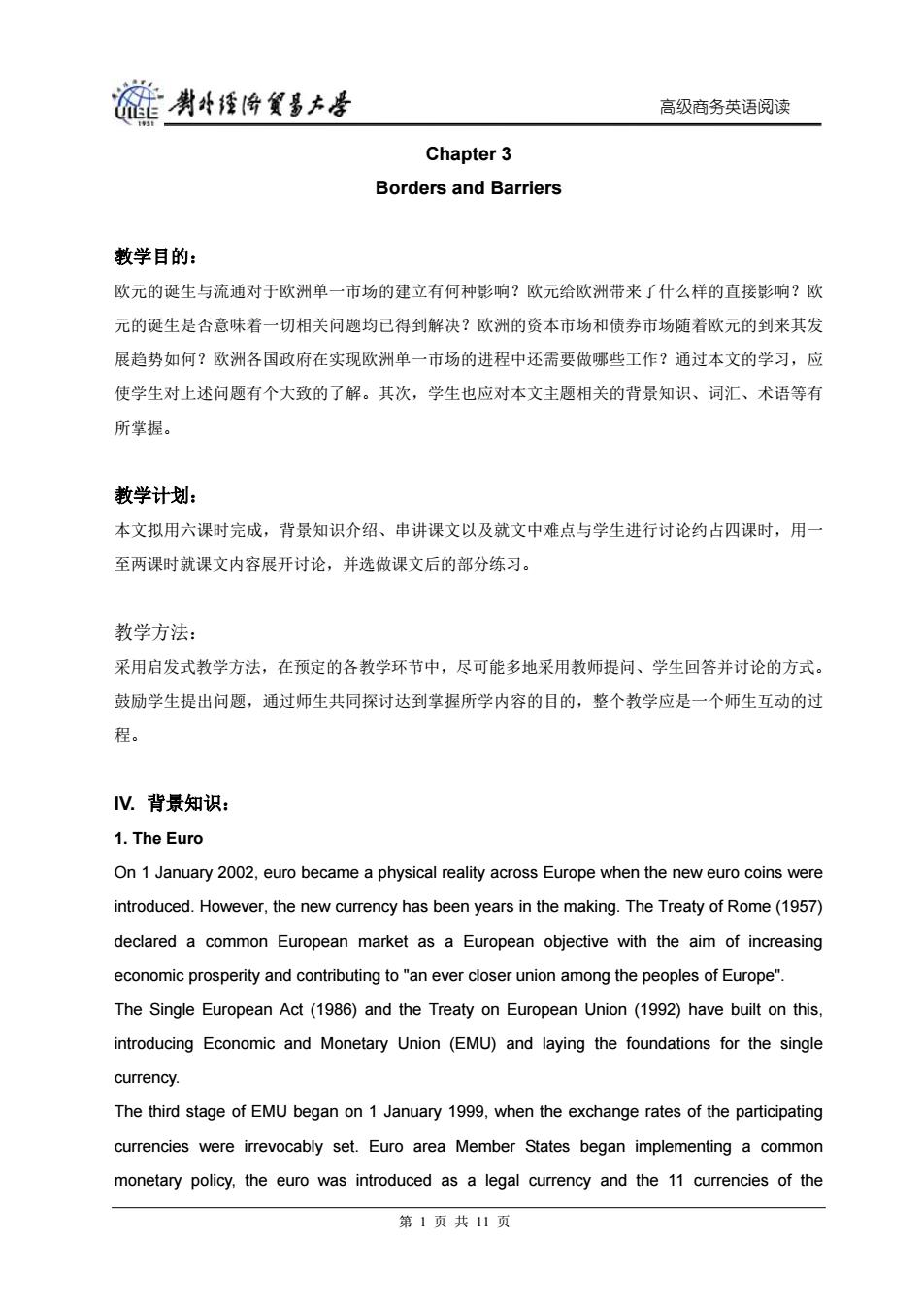
莲喇母矮降贸多大学 高级商务英语阅读 Chapter 3 Borders and Barriers 教学目的: 欧元的诞生与流通对于欧洲单一市场的建立有何种影响?欧元给欧洲带来了什么样的直接影响?欧 元的诞生是否意味着一切相关问题均已得到解决?欧洲的资本市场和债券市场随着欧元的到来其发 展趋势如何?欧洲各国政府在实现欧洲单一市场的进程中还需要做哪些工作?通过本文的学习,应 使学生对上述问题有个大致的了解。其次,学生也应对本文主题相关的背景知识、词汇、术语等有 所掌握。 教学计划: 本文拟用六课时完成,背景知识介绍、串讲课文以及就文中难点与学生进行讨论约占四课时,用一 至两课时就课文内容展开讨论,并选做课文后的部分练习。 教学方法: 采用启发式教学方法,在预定的各教学环节中,尽可能多地采用教师提问、学生回答并讨论的方式。 鼓励学生提出问题,通过师生共同探讨达到掌握所学内容的目的,整个教学应是一个师生互动的过 程。 IV.背景知识: 1.The Euro On 1 January 2002,euro became a physical reality across Europe when the new euro coins were introduced.However,the new currency has been years in the making.The Treaty of Rome(1957) declared a common European market as a European objective with the aim of increasing economic prosperity and contributing to"an ever closer union among the peoples of Europe". The Single European Act(1986)and the Treaty on European Union(1992)have built on this, introducing Economic and Monetary Union (EMU)and laying the foundations for the single currency. The third stage of EMU began on 1 January 1999,when the exchange rates of the participating currencies were irrevocably set.Euro area Member States began implementing a common monetary policy,the euro was introduced as a legal currency and the 11 currencies of the 第1页共11页
高级商务英语阅读 Chapter 3 Borders and Barriers 教学目的: 欧元的诞生与流通对于欧洲单一市场的建立有何种影响?欧元给欧洲带来了什么样的直接影响?欧 元的诞生是否意味着一切相关问题均已得到解决?欧洲的资本市场和债券市场随着欧元的到来其发 展趋势如何?欧洲各国政府在实现欧洲单一市场的进程中还需要做哪些工作?通过本文的学习,应 使学生对上述问题有个大致的了解。其次,学生也应对本文主题相关的背景知识、词汇、术语等有 所掌握。 教学计划: 本文拟用六课时完成,背景知识介绍、串讲课文以及就文中难点与学生进行讨论约占四课时,用一 至两课时就课文内容展开讨论,并选做课文后的部分练习。 教学方法: 采用启发式教学方法,在预定的各教学环节中,尽可能多地采用教师提问、学生回答并讨论的方式。 鼓励学生提出问题,通过师生共同探讨达到掌握所学内容的目的,整个教学应是一个师生互动的过 程。 IV. 背景知识: 1. The Euro On 1 January 2002, euro became a physical reality across Europe when the new euro coins were introduced. However, the new currency has been years in the making. The Treaty of Rome (1957) declared a common European market as a European objective with the aim of increasing economic prosperity and contributing to "an ever closer union among the peoples of Europe". The Single European Act (1986) and the Treaty on European Union (1992) have built on this, introducing Economic and Monetary Union (EMU) and laying the foundations for the single currency. The third stage of EMU began on 1 January 1999, when the exchange rates of the participating currencies were irrevocably set. Euro area Member States began implementing a common monetary policy, the euro was introduced as a legal currency and the 11 currencies of the 第 1 页 共 11 页
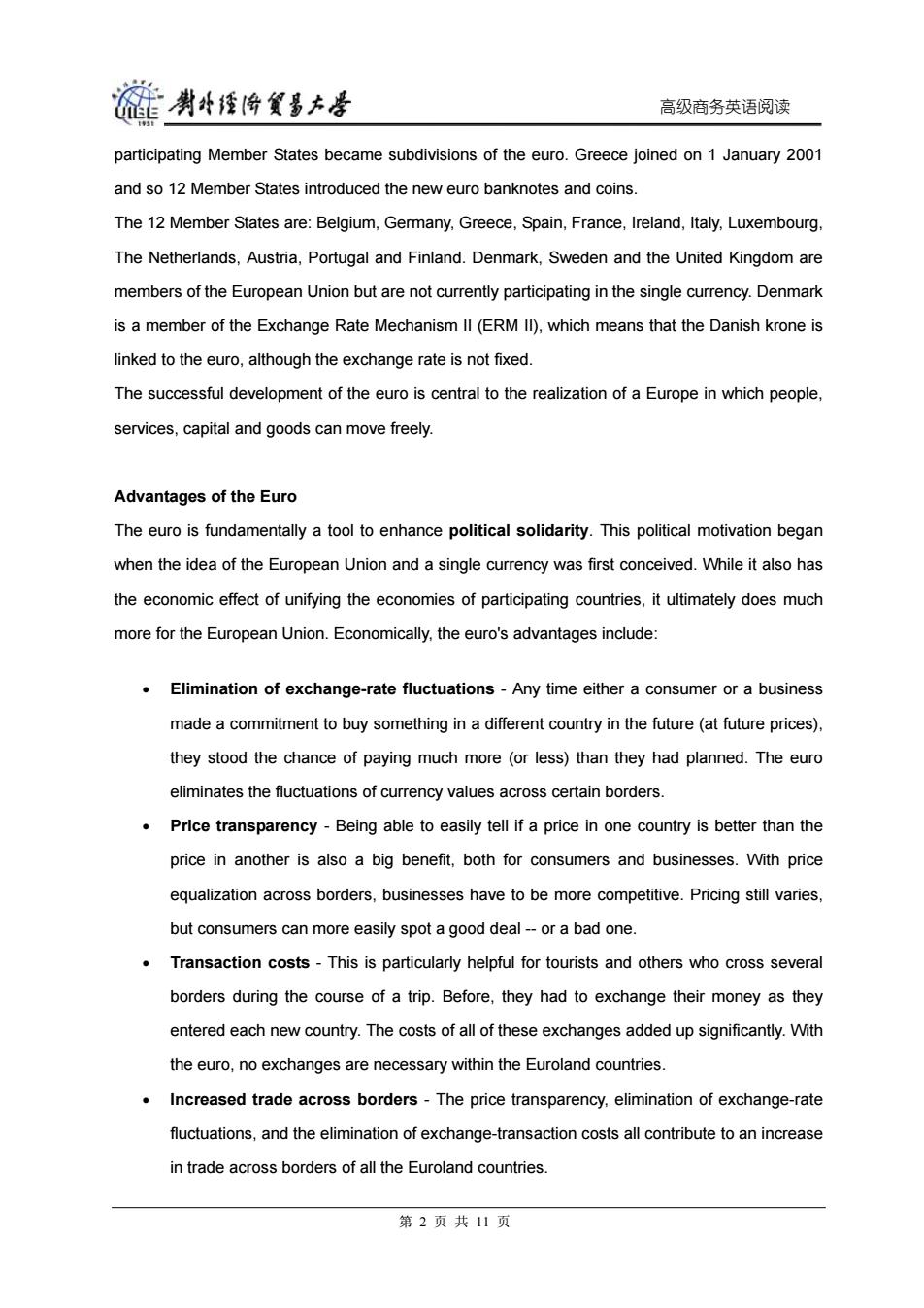
雒勇降贸多大是 高级商务英语阅读 participating Member States became subdivisions of the euro.Greece joined on 1 January 2001 and so 12 Member States introduced the new euro banknotes and coins. The 12 Member States are:Belgium,Germany,Greece,Spain,France,Ireland,Italy,Luxembourg, The Netherlands,Austria,Portugal and Finland.Denmark,Sweden and the United Kingdom are members of the European Union but are not currently participating in the single currency.Denmark is a member of the Exchange Rate Mechanism Il(ERM II),which means that the Danish krone is linked to the euro,although the exchange rate is not fixed. The successful development of the euro is central to the realization of a Europe in which people, services,capital and goods can move freely. Advantages of the Euro The euro is fundamentally a tool to enhance political solidarity.This political motivation began when the idea of the European Union and a single currency was first conceived.While it also has the economic effect of unifying the economies of participating countries,it ultimately does much more for the European Union.Economically,the euro's advantages include: Elimination of exchange-rate fluctuations-Any time either a consumer or a business made a commitment to buy something in a different country in the future(at future prices), they stood the chance of paying much more(or less)than they had planned.The euro eliminates the fluctuations of currency values across certain borders. Price transparency-Being able to easily tell if a price in one country is better than the price in another is also a big benefit,both for consumers and businesses.With price equalization across borders,businesses have to be more competitive.Pricing still varies, but consumers can more easily spot a good deal--or a bad one Transaction costs-This is particularly helpful for tourists and others who cross several borders during the course of a trip.Before,they had to exchange their money as they entered each new country.The costs of all of these exchanges added up significantly.With the euro,no exchanges are necessary within the Euroland countries. Increased trade across borders-The price transparency,elimination of exchange-rate fluctuations,and the elimination of exchange-transaction costs all contribute to an increase in trade across borders of all the Euroland countries. 第2页共11页
高级商务英语阅读 participating Member States became subdivisions of the euro. Greece joined on 1 January 2001 and so 12 Member States introduced the new euro banknotes and coins. The 12 Member States are: Belgium, Germany, Greece, Spain, France, Ireland, Italy, Luxembourg, The Netherlands, Austria, Portugal and Finland. Denmark, Sweden and the United Kingdom are members of the European Union but are not currently participating in the single currency. Denmark is a member of the Exchange Rate Mechanism II (ERM II), which means that the Danish krone is linked to the euro, although the exchange rate is not fixed. The successful development of the euro is central to the realization of a Europe in which people, services, capital and goods can move freely. Advantages of the Euro The euro is fundamentally a tool to enhance political solidarity. This political motivation began when the idea of the European Union and a single currency was first conceived. While it also has the economic effect of unifying the economies of participating countries, it ultimately does much more for the European Union. Economically, the euro's advantages include: • Elimination of exchange-rate fluctuations - Any time either a consumer or a business made a commitment to buy something in a different country in the future (at future prices), they stood the chance of paying much more (or less) than they had planned. The euro eliminates the fluctuations of currency values across certain borders. • Price transparency - Being able to easily tell if a price in one country is better than the price in another is also a big benefit, both for consumers and businesses. With price equalization across borders, businesses have to be more competitive. Pricing still varies, but consumers can more easily spot a good deal -- or a bad one. • Transaction costs - This is particularly helpful for tourists and others who cross several borders during the course of a trip. Before, they had to exchange their money as they entered each new country. The costs of all of these exchanges added up significantly. With the euro, no exchanges are necessary within the Euroland countries. • Increased trade across borders - The price transparency, elimination of exchange-rate fluctuations, and the elimination of exchange-transaction costs all contribute to an increase in trade across borders of all the Euroland countries. 第 2 页 共 11 页
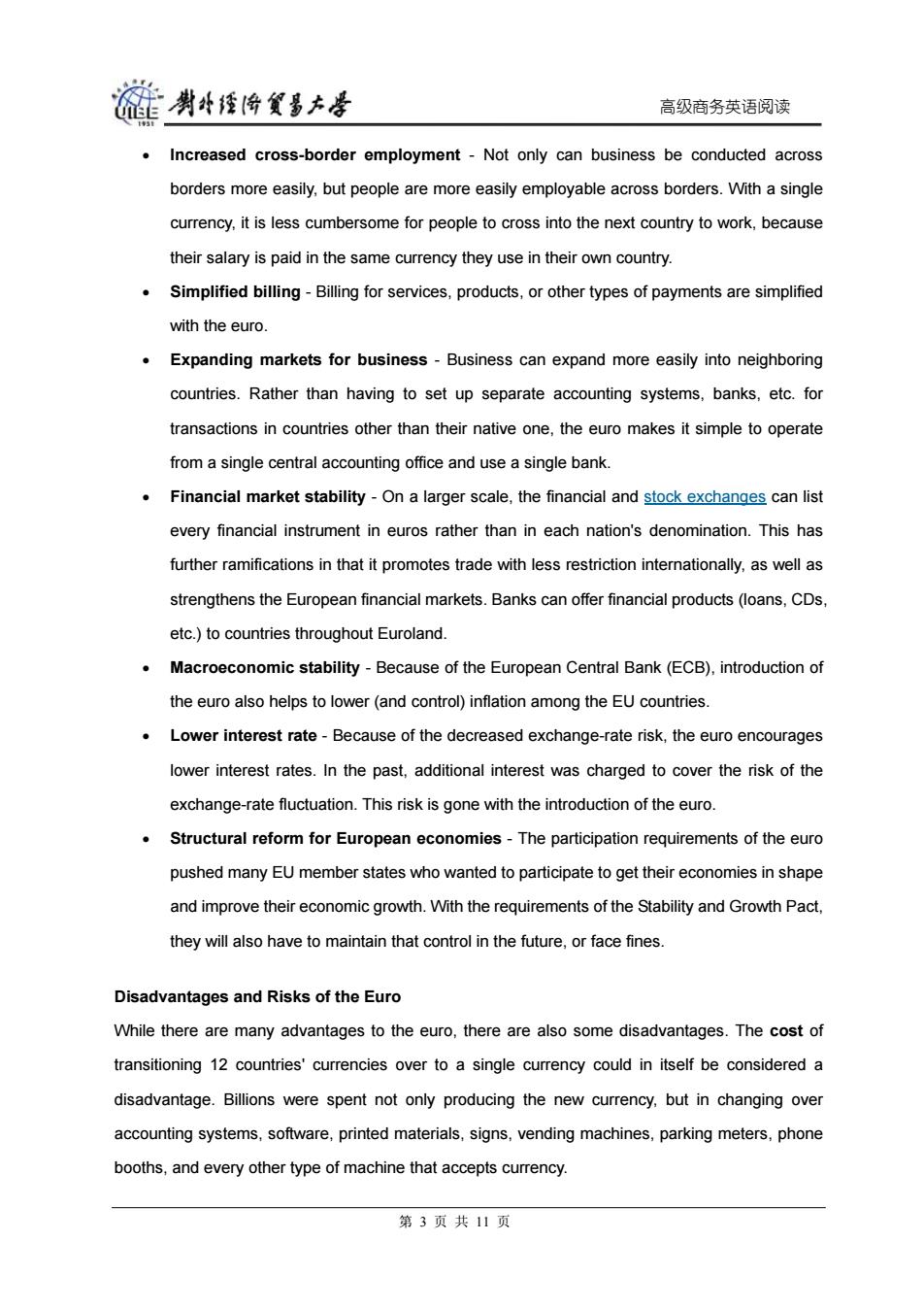
莲剥4将发多大号 高级商务英语阅读 Increased cross-border employment -Not only can business be conducted across borders more easily,but people are more easily employable across borders.With a single currency,it is less cumbersome for people to cross into the next country to work,because their salary is paid in the same currency they use in their own country. Simplified billing-Billing for services,products,or other types of payments are simplified with the euro. Expanding markets for business-Business can expand more easily into neighboring countries.Rather than having to set up separate accounting systems,banks,etc.for transactions in countries other than their native one,the euro makes it simple to operate from a single central accounting office and use a single bank. Financial market stability-On a larger scale,the financial and stock exchanges can list every financial instrument in euros rather than in each nation's denomination.This has further ramifications in that it promotes trade with less restriction internationally,as well as strengthens the European financial markets.Banks can offer financial products (loans,CDs, etc.)to countries throughout Euroland. Macroeconomic stability-Because of the European Central Bank(ECB),introduction of the euro also helps to lower(and control)inflation among the EU countries. Lower interest rate-Because of the decreased exchange-rate risk,the euro encourages lower interest rates.In the past,additional interest was charged to cover the risk of the exchange-rate fluctuation.This risk is gone with the introduction of the euro. Structural reform for European economies-The participation requirements of the euro pushed many EU member states who wanted to participate to get their economies in shape and improve their economic growth.With the requirements of the Stability and Growth Pact, they will also have to maintain that control in the future,or face fines. Disadvantages and Risks of the Euro While there are many advantages to the euro,there are also some disadvantages.The cost of transitioning 12 countries'currencies over to a single currency could in itself be considered a disadvantage.Billions were spent not only producing the new currency,but in changing over accounting systems,software,printed materials,signs,vending machines,parking meters,phone booths,and every other type of machine that accepts currency. 第3页共11页
高级商务英语阅读 • Increased cross-border employment - Not only can business be conducted across borders more easily, but people are more easily employable across borders. With a single currency, it is less cumbersome for people to cross into the next country to work, because their salary is paid in the same currency they use in their own country. • Simplified billing - Billing for services, products, or other types of payments are simplified with the euro. • Expanding markets for business - Business can expand more easily into neighboring countries. Rather than having to set up separate accounting systems, banks, etc. for transactions in countries other than their native one, the euro makes it simple to operate from a single central accounting office and use a single bank. • Financial market stability - On a larger scale, the financial and stock exchanges can list every financial instrument in euros rather than in each nation's denomination. This has further ramifications in that it promotes trade with less restriction internationally, as well as strengthens the European financial markets. Banks can offer financial products (loans, CDs, etc.) to countries throughout Euroland. • Macroeconomic stability - Because of the European Central Bank (ECB), introduction of the euro also helps to lower (and control) inflation among the EU countries. • Lower interest rate - Because of the decreased exchange-rate risk, the euro encourages lower interest rates. In the past, additional interest was charged to cover the risk of the exchange-rate fluctuation. This risk is gone with the introduction of the euro. • Structural reform for European economies - The participation requirements of the euro pushed many EU member states who wanted to participate to get their economies in shape and improve their economic growth. With the requirements of the Stability and Growth Pact, they will also have to maintain that control in the future, or face fines. Disadvantages and Risks of the Euro While there are many advantages to the euro, there are also some disadvantages. The cost of transitioning 12 countries' currencies over to a single currency could in itself be considered a disadvantage. Billions were spent not only producing the new currency, but in changing over accounting systems, software, printed materials, signs, vending machines, parking meters, phone booths, and every other type of machine that accepts currency. 第 3 页 共 11 页

链剥将发多大是 高级商务英语阅读 In addition,there were hours of training necessary for employees,managers,and even consumers.Every government from national to local had impact costs of the transition.This enormous task required many hours of organization,planning,and implementation,which fell on the shoulders of government agencies. The chance of economic shock is another risk that comes along with the introduction of a single currency.On a macroeconomic level,fluctuations have in the past been controllable by each country. With their own national currencies,countries could adjust interest rates to encourage investments and large consumer purchases. The euro makes interest-rate adjustments by individual countries impossible,so this form of recovery is lost.Interest rates for all of Euroland are controlled by the European Central Bank. They could also devalue their currency in an economic downturn by adjusting their exchange rate.This devaluation would encourage foreign purchases of their goods,which would then help bring the economy back to where it needed to be. Since there is no longer an individual national currency,this method of economic recovery is also lost.There is no exchange-rate fluctuation for individual euro countries. A third way they could adjust to economic shocks was through adjustments in government spending,such as unemployment and social welfare programs.In times of economic difficulty,when lay-offs increase and more citizens need unemployment benefits and other welfare funding,the government's spending increases to make these payments.This puts money back into the economy and encourages spending,which helps bring the country out of its recession. Because of the Stability and Growth Pact,governments are restricted to keeping their budget deficits within the requirements of the pact.This limits their freedom in spending 第4页共11页
高级商务英语阅读 In addition, there were hours of training necessary for employees, managers, and even consumers. Every government from national to local had impact costs of the transition. This enormous task required many hours of organization, planning, and implementation, which fell on the shoulders of government agencies. The chance of economic shock is another risk that comes along with the introduction of a single currency. On a macroeconomic level, fluctuations have in the past been controllable by each country. • With their own national currencies, countries could adjust interest rates to encourage investments and large consumer purchases. The euro makes interest-rate adjustments by individual countries impossible, so this form of recovery is lost. Interest rates for all of Euroland are controlled by the European Central Bank. • They could also devalue their currency in an economic downturn by adjusting their exchange rate. This devaluation would encourage foreign purchases of their goods, which would then help bring the economy back to where it needed to be. Since there is no longer an individual national currency, this method of economic recovery is also lost. There is no exchange-rate fluctuation for individual euro countries. • A third way they could adjust to economic shocks was through adjustments in government spending, such as unemployment and social welfare programs. In times of economic difficulty, when lay-offs increase and more citizens need unemployment benefits and other welfare funding, the government's spending increases to make these payments. This puts money back into the economy and encourages spending, which helps bring the country out of its recession. Because of the Stability and Growth Pact, governments are restricted to keeping their budget deficits within the requirements of the pact. This limits their freedom in spending 第 4 页 共 11 页
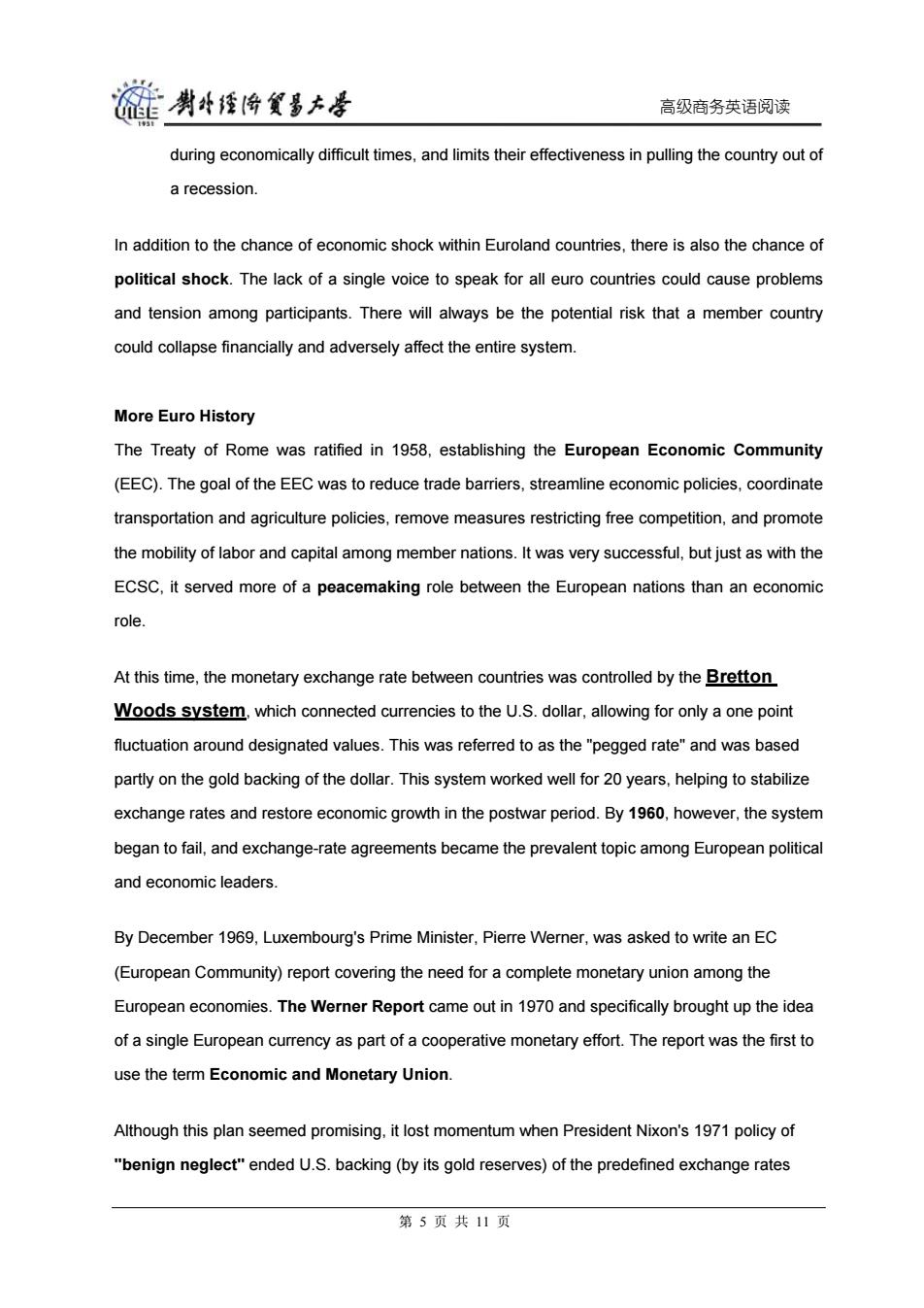
莲类4睡降发多大号 高级商务英语阅读 during economically difficult times,and limits their effectiveness in pulling the country out of a recession. In addition to the chance of economic shock within Euroland countries,there is also the chance of political shock.The lack of a single voice to speak for all euro countries could cause problems and tension among participants.There will always be the potential risk that a member country could collapse financially and adversely affect the entire system. More Euro History The Treaty of Rome was ratified in 1958,establishing the European Economic Community (EEC).The goal of the EEC was to reduce trade barriers,streamline economic policies,coordinate transportation and agriculture policies,remove measures restricting free competition,and promote the mobility of labor and capital among member nations.It was very successful,but just as with the ECSC,it served more of a peacemaking role between the European nations than an economic role At this time,the monetary exchange rate between countries was controlled by the Bretton Woods system,which connected currencies to the U.S.dollar,allowing for only a one point fluctuation around designated values.This was referred to as the"pegged rate"and was based partly on the gold backing of the dollar.This system worked well for 20 years,helping to stabilize exchange rates and restore economic growth in the postwar period.By 1960,however,the system began to fail,and exchange-rate agreements became the prevalent topic among European political and economic leaders. By December 1969,Luxembourg's Prime Minister,Pierre Werner,was asked to write an EC (European Community)report covering the need for a complete monetary union among the European economies.The Werner Report came out in 1970 and specifically brought up the idea of a single European currency as part of a cooperative monetary effort.The report was the first to use the term Economic and Monetary Union. Although this plan seemed promising,it lost momentum when President Nixon's 1971 policy of "benign neglect"ended U.S.backing(by its gold reserves)of the predefined exchange rates 第5页共11页
高级商务英语阅读 during economically difficult times, and limits their effectiveness in pulling the country out of a recession. In addition to the chance of economic shock within Euroland countries, there is also the chance of political shock. The lack of a single voice to speak for all euro countries could cause problems and tension among participants. There will always be the potential risk that a member country could collapse financially and adversely affect the entire system. More Euro History The Treaty of Rome was ratified in 1958, establishing the European Economic Community (EEC). The goal of the EEC was to reduce trade barriers, streamline economic policies, coordinate transportation and agriculture policies, remove measures restricting free competition, and promote the mobility of labor and capital among member nations. It was very successful, but just as with the ECSC, it served more of a peacemaking role between the European nations than an economic role. At this time, the monetary exchange rate between countries was controlled by the Bretton Woods system, which connected currencies to the U.S. dollar, allowing for only a one point fluctuation around designated values. This was referred to as the "pegged rate" and was based partly on the gold backing of the dollar. This system worked well for 20 years, helping to stabilize exchange rates and restore economic growth in the postwar period. By 1960, however, the system began to fail, and exchange-rate agreements became the prevalent topic among European political and economic leaders. By December 1969, Luxembourg's Prime Minister, Pierre Werner, was asked to write an EC (European Community) report covering the need for a complete monetary union among the European economies. The Werner Report came out in 1970 and specifically brought up the idea of a single European currency as part of a cooperative monetary effort. The report was the first to use the term Economic and Monetary Union. Although this plan seemed promising, it lost momentum when President Nixon's 1971 policy of "benign neglect" ended U.S. backing (by its gold reserves) of the predefined exchange rates 第 5 页 共 11 页

链剥科经将食多大孝 高级商务英语阅读 against the dollar,collapsing the Bretton Woods system.Other foreign central banks were not willing to support the dollar,which would have provided the equivalent of deposit insurance. So where did that leave the European countries when it came to the stability of their currencies?It brought about the development in 1979 of the European Monetary System(EMS),which locked exchange rates among the participating countries into predefined trading zones.This was known as the Exchange Rate Mechanism(EMS).This move,in itself,stabilized the economy by creating predictable trading zones. The next move toward a unified European economy came with the 1987 Single European Act This act called for the systematic removal of barriers and restrictions that hampered trade between European countries.As a result,border checks,tariffs,customs,labor restrictions and other barriers to free trade were dismantled. 2.Andrew K.Rose Professor of Economic Analysis and Policy,Haas School of Business,University of California Berkeley.Managing Editor of The Journal of International Economics(1995-2001).Acting Director, International Finance and Macroeconomics Program of the NBER,(1996-1999).Ph.D. Massachusetts Institute of Technology (1983-1986). 3.University of California at Berkeley The University grew with the rapidly expanding population of California and responded to the educational needs of the developing state.As early as 1960's,Berkeley was recognized by the American Council on Education as "the best balanced distinguished university in the country." Today,it is one of the best known universities in the world. 4.Subramanian Rangan Associate Professor of Strategy and Management Subi Rangan received an MBA from the MIT Sloan School of Management and a Ph.D.from Harvard University.His research and teaching interests revolve around the strategic and managerial challenges facing multinational firms.In 1998,Professor Rangan won the Academy of International Business'Eldridge Haynes Prize (awarded biennially to a scholar under forty)for the 第6页共11页
高级商务英语阅读 against the dollar, collapsing the Bretton Woods system. Other foreign central banks were not willing to support the dollar, which would have provided the equivalent of deposit insurance. So where did that leave the European countries when it came to the stability of their currencies? It brought about the development in 1979 of the European Monetary System (EMS), which locked exchange rates among the participating countries into predefined trading zones. This was known as the Exchange Rate Mechanism (EMS). This move, in itself, stabilized the economy by creating predictable trading zones. The next move toward a unified European economy came with the 1987 Single European Act. This act called for the systematic removal of barriers and restrictions that hampered trade between European countries. As a result, border checks, tariffs, customs, labor restrictions and other barriers to free trade were dismantled. 2. Andrew K. Rose Professor of Economic Analysis and Policy, Haas School of Business, University of California Berkeley. Managing Editor of The Journal of International Economics (1995-2001). Acting Director, International Finance and Macroeconomics Program of the NBER, (1996-1999). Ph.D. Massachusetts Institute of Technology (1983-1986). 3. University of California at Berkeley The University grew with the rapidly expanding population of California and responded to the educational needs of the developing state. As early as 1960’s, Berkeley was recognized by the American Council on Education as "the best balanced distinguished university in the country." Today, it is one of the best known universities in the world. 4. Subramanian Rangan Associate Professor of Strategy and Management Subi Rangan received an MBA from the MIT Sloan School of Management and a Ph.D. from Harvard University. His research and teaching interests revolve around the strategic and managerial challenges facing multinational firms. In 1998, Professor Rangan won the Academy of International Business’ Eldridge Haynes Prize (awarded biennially to a scholar under forty) for the 第 6 页 共 11 页
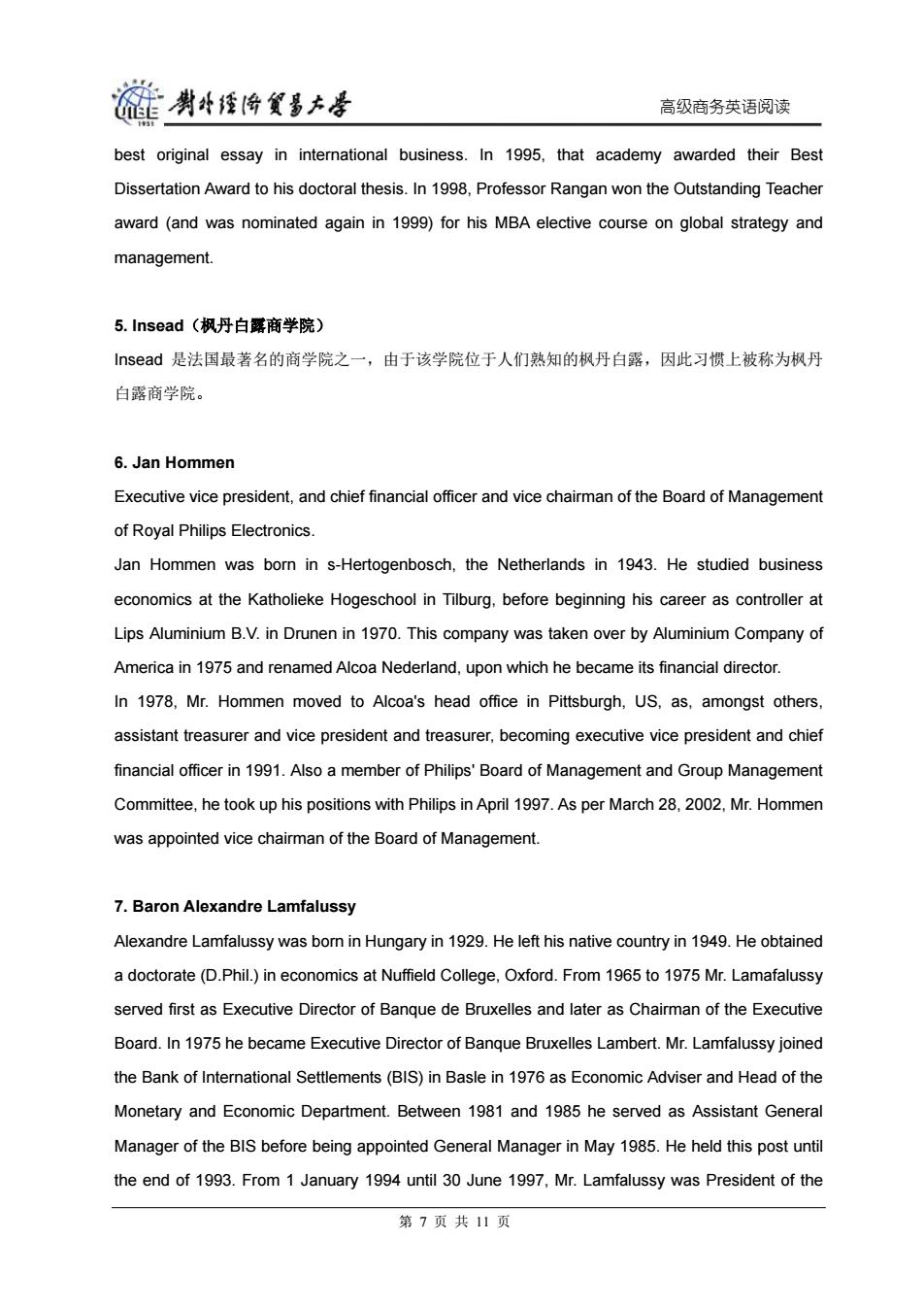
碰男华经海贸多大学 高级商务英语阅读 best original essay in international business.In 1995,that academy awarded their Best Dissertation Award to his doctoral thesis.In 1998,Professor Rangan won the Outstanding Teacher award (and was nominated again in 1999)for his MBA elective course on global strategy and management. 5.Insead(枫丹白露商学院) Insead是法国最著名的商学院之一,由于该学院位于人们熟知的枫丹白露,因此习惯上被称为枫丹 白露商学院。 6.Jan Hommen Executive vice president,and chief financial officer and vice chairman of the Board of Management of Royal Philips Electronics. Jan Hommen was born in s-Hertogenbosch,the Netherlands in 1943.He studied business economics at the Katholieke Hogeschool in Tilburg,before beginning his career as controller at Lips Aluminium B.V.in Drunen in 1970.This company was taken over by Aluminium Company of America in 1975 and renamed Alcoa Nederland,upon which he became its financial director. In 1978,Mr.Hommen moved to Alcoa's head office in Pittsburgh,US,as,amongst others, assistant treasurer and vice president and treasurer,becoming executive vice president and chief financial officer in 1991.Also a member of Philips'Board of Management and Group Management Committee,he took up his positions with Philips in April 1997.As per March 28,2002,Mr.Hommen was appointed vice chairman of the Board of Management. 7.Baron Alexandre Lamfalussy Alexandre Lamfalussy was born in Hungary in 1929.He left his native country in 1949.He obtained a doctorate(D.Phil.)in economics at Nuffield College,Oxford.From 1965 to 1975 Mr.Lamafalussy served first as Executive Director of Banque de Bruxelles and later as Chairman of the Executive Board.In 1975 he became Executive Director of Banque Bruxelles Lambert.Mr.Lamfalussy joined the Bank of International Settlements(BIS)in Basle in 1976 as Economic Adviser and Head of the Monetary and Economic Department.Between 1981 and 1985 he served as Assistant General Manager of the BIS before being appointed General Manager in May 1985.He held this post until the end of 1993.From 1 January 1994 until 30 June 1997,Mr.Lamfalussy was President of the 第7页共11页
高级商务英语阅读 best original essay in international business. In 1995, that academy awarded their Best Dissertation Award to his doctoral thesis. In 1998, Professor Rangan won the Outstanding Teacher award (and was nominated again in 1999) for his MBA elective course on global strategy and management. 5. Insead(枫丹白露商学院) Insead 是法国最著名的商学院之一,由于该学院位于人们熟知的枫丹白露,因此习惯上被称为枫丹 白露商学院。 6. Jan Hommen Executive vice president, and chief financial officer and vice chairman of the Board of Management of Royal Philips Electronics. Jan Hommen was born in s-Hertogenbosch, the Netherlands in 1943. He studied business economics at the Katholieke Hogeschool in Tilburg, before beginning his career as controller at Lips Aluminium B.V. in Drunen in 1970. This company was taken over by Aluminium Company of America in 1975 and renamed Alcoa Nederland, upon which he became its financial director. In 1978, Mr. Hommen moved to Alcoa's head office in Pittsburgh, US, as, amongst others, assistant treasurer and vice president and treasurer, becoming executive vice president and chief financial officer in 1991. Also a member of Philips' Board of Management and Group Management Committee, he took up his positions with Philips in April 1997. As per March 28, 2002, Mr. Hommen was appointed vice chairman of the Board of Management. 7. Baron Alexandre Lamfalussy Alexandre Lamfalussy was born in Hungary in 1929. He left his native country in 1949. He obtained a doctorate (D.Phil.) in economics at Nuffield College, Oxford. From 1965 to 1975 Mr. Lamafalussy served first as Executive Director of Banque de Bruxelles and later as Chairman of the Executive Board. In 1975 he became Executive Director of Banque Bruxelles Lambert. Mr. Lamfalussy joined the Bank of International Settlements (BIS) in Basle in 1976 as Economic Adviser and Head of the Monetary and Economic Department. Between 1981 and 1985 he served as Assistant General Manager of the BIS before being appointed General Manager in May 1985. He held this post until the end of 1993. From 1 January 1994 until 30 June 1997, Mr. Lamfalussy was President of the 第 7 页 共 11 页

雒剥经降置昌大号 高级商务英语阅读 European Monetary Institute in Frankfurt Since 1997 he has been teaching and doing research at the"Institut d'Etudes Europeennes"of the Catholic University of Louvain in Louvain-la-Neuve. V.课文讲解 1.For all that it has clearly had profound effects already,and will have even deeper ones after January 1st,the euro by itself can only do so much.(p.50) 本句中的主句为the euro by itself can only do so much,其中euro是主语。For all that it has clearly had profound effects already,and will have even deeper ones after January1st为介词短语,在整个 句子当中作状语。介词短语中的that引导出一个定语从句,修饰a。代词it此处指euro。 2.One useful strand of research led by Andrew Rose,an economist at the University of California at Berkeley,suggests that thanks to the single currency,intra-European trade should fairly quickly double or even treble in volume.(p.50) 可提醒学生本句中的double和treble的意思分别为“是...的两倍或增加一倍”以及“是...的三倍 或增加两倍。”请看下面的例句: 1)The cash flow is expected to treble next year.(意思是现金流转预计增加两倍。) 2)The cast double and treble their roles and all∥make memorable contributions.(意思是每位演员 演两个或三个角色。) 3)China's existing network is already aiming to more than treble in size this year. 4)The leap of a kangaroo is double that of the human Olympic record. 5)The expanding opportunities,especially in manufacturing,meant that in some districts the earnings of women and children were able to double family income. 3.If that turns out to be correct,then Europe will greatly surprise the numerous pessimists who have bemoaned its inability to pick up where America's decade of extraordinary economic growth has left off.(p.50) 英语中to pick up where(+其他成分)+主语+leave off表示“从以前的某处重新开始或继续下去。”例 如,教师上课对学生说要接着上次课往下讲,节目主持人重提前面的话题等情况,均可以说Let's pick up where we left off."再看下面的例句: 第8页共11页
高级商务英语阅读 European Monetary Institute in Frankfurt. Since 1997 he has been teaching and doing research at the "Institut d'Etudes Europeennes" of the Catholic University of Louvain in Louvain-la-Neuve. V.课文讲解 1. For all that it has clearly had profound effects already, and will have even deeper ones after January 1st, the euro by itself can only do so much. (p. 50) 本句中的主句为the euro by itself can only do so much,其中euro是主语。For all that it has clearly had profound effects already, and will have even deeper ones after January 1st为介词短语,在整个 句子当中作状语。介词短语中的that引导出一个定语从句,修饰all。代词it此处指euro。 2. One useful strand of research led by Andrew Rose, an economist at the University of California at Berkeley, suggests that thanks to the single currency, intra-European trade should fairly quickly double or even treble in volume. (p. 50) 可提醒学生本句中的 double 和 treble 的意思分别为 “是……的两倍或增加一倍” 以及“是……的三倍 或增加两倍。”请看下面的例句: 1) The cash flow is expected to treble next year. (意思是现金流转预计增加两倍。) 2) The cast double and treble their roles and all make memorable contributions.(意思是每位演员 演两个或三个角色。) 3) China's existing network is already aiming to more than treble in size this year. 4) The leap of a kangaroo is double that of the human Olympic record. 5) The expanding opportunities, especially in manufacturing, meant that in some districts the earnings of women and children were able to double family income. 3. If that turns out to be correct, then Europe will greatly surprise the numerous pessimists who have bemoaned its inability to pick up where America’s decade of extraordinary economic growth has left off. (p. 50) 英语中 to pick up where (+其他成分)+主语+leave off 表示“从以前的某处重新开始或继续下去。”例 如,教师上课对学生说要接着上次课往下讲;节目主持人重提前面的话题等情况,均可以说“Let’s pick up where we left off.”再看下面的例句: 第 8 页 共 11 页
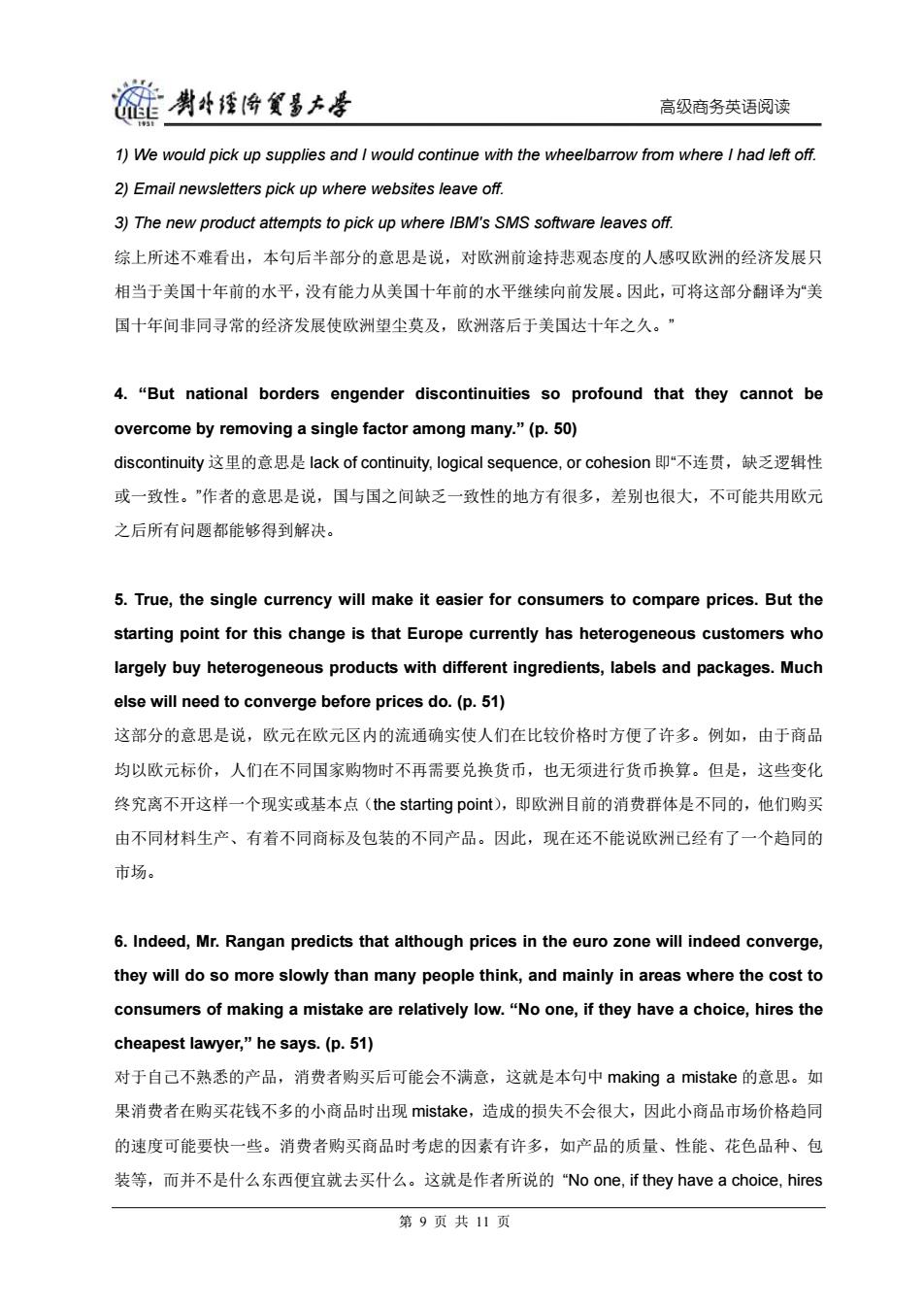
碰男华经海贸多大号 高级商务英语阅读 1)We would pick up supplies and I would continue with the wheelbarrow from where I had left off. 2)Email newsletters pick up where websites leave off. 3)The new product attempts to pick up where IBM's SMS software leaves off. 综上所述不难看出,本句后半部分的意思是说,对欧洲前途持悲观态度的人感叹欧洲的经济发展只 相当于美国十年前的水平,没有能力从美国十年前的水平继续向前发展。因此,可将这部分翻译为“美 国十年间非同寻常的经济发展使欧洲望尘莫及,欧洲落后于美国达十年之久。” 4."But national borders engender discontinuities so profound that they cannot be overcome by removing a single factor among many."(p.50) discontinuity这里的意思是lack of continuity,logical sequence,or cohesion即“不连贯,缺乏逻辑性 或一致性。”作者的意思是说,国与国之间缺乏一致性的地方有很多,差别也很大,不可能共用欧元 之后所有问题都能够得到解决。 5.True,the single currency will make it easier for consumers to compare prices.But the starting point for this change is that Europe currently has heterogeneous customers who largely buy heterogeneous products with different ingredients,labels and packages.Much else will need to converge before prices do.(p.51) 这部分的意思是说,欧元在欧元区内的流通确实使人们在比较价格时方便了许多。例如,由于商品 均以欧元标价,人们在不同国家购物时不再需要兑换货币,也无须进行货币换算。但是,这些变化 终究离不开这样一个现实或基本点(the starting point),即欧洲目前的消费群体是不同的,他们购买 由不同材料生产、有着不同商标及包装的不同产品。因此,现在还不能说欧洲已经有了一个趋同的 市场。 6.Indeed,Mr.Rangan predicts that although prices in the euro zone will indeed converge, they will do so more slowly than many people think,and mainly in areas where the cost to consumers of making a mistake are relatively low."No one,if they have a choice,hires the cheapest lawyer,"he says.(p.51) 对于自己不熟悉的产品,消费者购买后可能会不满意,这就是本句中making a mistake的意思。如 果消费者在购买花钱不多的小商品时出现mistake,造成的损失不会很大,因此小商品市场价格趋同 的速度可能要快一些。消费者购买商品时考虑的因素有许多,如产品的质量、性能、花色品种、包 装等,而并不是什么东西便宜就去买什么。这就是作者所说的“No one,if they have a choice,hires 第9页共11页
高级商务英语阅读 1) We would pick up supplies and I would continue with the wheelbarrow from where I had left off. 2) Email newsletters pick up where websites leave off. 3) The new product attempts to pick up where IBM's SMS software leaves off. 综上所述不难看出,本句后半部分的意思是说,对欧洲前途持悲观态度的人感叹欧洲的经济发展只 相当于美国十年前的水平,没有能力从美国十年前的水平继续向前发展。因此,可将这部分翻译为“美 国十年间非同寻常的经济发展使欧洲望尘莫及,欧洲落后于美国达十年之久。” 4. “But national borders engender discontinuities so profound that they cannot be overcome by removing a single factor among many.” (p. 50) discontinuity 这里的意思是 lack of continuity, logical sequence, or cohesion 即“不连贯,缺乏逻辑性 或一致性。”作者的意思是说,国与国之间缺乏一致性的地方有很多,差别也很大,不可能共用欧元 之后所有问题都能够得到解决。 5. True, the single currency will make it easier for consumers to compare prices. But the starting point for this change is that Europe currently has heterogeneous customers who largely buy heterogeneous products with different ingredients, labels and packages. Much else will need to converge before prices do. (p. 51) 这部分的意思是说,欧元在欧元区内的流通确实使人们在比较价格时方便了许多。例如,由于商品 均以欧元标价,人们在不同国家购物时不再需要兑换货币,也无须进行货币换算。但是,这些变化 终究离不开这样一个现实或基本点(the starting point),即欧洲目前的消费群体是不同的,他们购买 由不同材料生产、有着不同商标及包装的不同产品。因此,现在还不能说欧洲已经有了一个趋同的 市场。 6. Indeed, Mr. Rangan predicts that although prices in the euro zone will indeed converge, they will do so more slowly than many people think, and mainly in areas where the cost to consumers of making a mistake are relatively low. “No one, if they have a choice, hires the cheapest lawyer,” he says. (p. 51) 对于自己不熟悉的产品,消费者购买后可能会不满意,这就是本句中 making a mistake 的意思。如 果消费者在购买花钱不多的小商品时出现 mistake,造成的损失不会很大,因此小商品市场价格趋同 的速度可能要快一些。消费者购买商品时考虑的因素有许多,如产品的质量、性能、花色品种、包 装等,而并不是什么东西便宜就去买什么。这就是作者所说的 “No one, if they have a choice, hires 第 9 页 共 11 页
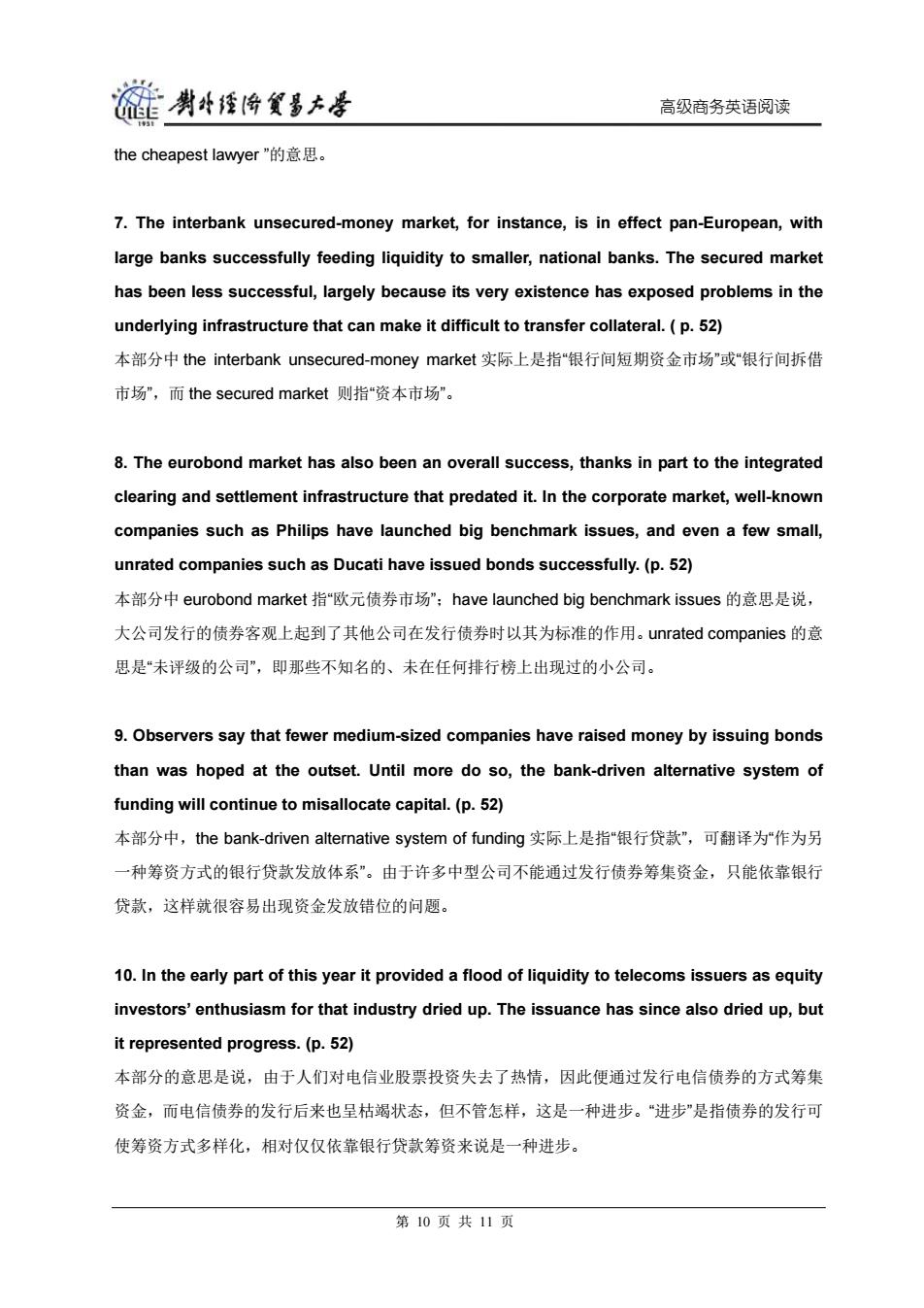
碰男华经海贸多大学 高级商务英语阅读 the cheapest lawyer"的意思。 7.The interbank unsecured-money market,for instance,is in effect pan-European,with large banks successfully feeding liquidity to smaller,national banks.The secured market has been less successful,largely because its very existence has exposed problems in the underlying infrastructure that can make it difficult to transfer collateral.p.52) 本部分中the interbank unsecured-money market实际上是指“银行间短期资金市场”或“银行间拆借 市场”,而the secured market则指“资本市场”。 8.The eurobond market has also been an overall success,thanks in part to the integrated clearing and settlement infrastructure that predated it.In the corporate market,well-known companies such as Philips have launched big benchmark issues,and even a few small, unrated companies such as Ducati have issued bonds successfully.(p.52) 本部分中eurobond market:指“欧元债券市场";have launched big benchmark issues的意思是说, 大公司发行的债券客观上起到了其他公司在发行债券时以其为标准的作用。unrated companies的意 思是“未评级的公司”,即那些不知名的、未在任何排行榜上出现过的小公司。 9.Observers say that fewer medium-sized companies have raised money by issuing bonds than was hoped at the outset.Until more do so,the bank-driven alternative system of funding will continue to misallocate capital.(p.52) 本部分中,the bank-driven alternative system of funding实际上是指“银行贷款",可翻译为“作为另 一种筹资方式的银行贷款发放体系”。由于许多中型公司不能通过发行债券筹集资金,只能依靠银行 贷款,这样就很容易出现资金发放错位的问题。 10.In the early part of this year it provided a flood of liquidity to telecoms issuers as equity investors'enthusiasm for that industry dried up.The issuance has since also dried up,but it represented progress.(p.52) 本部分的意思是说,由于人们对电信业股票投资失去了热情,因此便通过发行电信债券的方式筹集 资金,而电信债券的发行后来也呈枯竭状态,但不管怎样,这是一种进步。“进步”是指债券的发行可 使筹资方式多样化,相对仅仅依靠银行贷款筹资来说是一种进步。 第10页共11页
高级商务英语阅读 the cheapest lawyer ”的意思。 7. The interbank unsecured-money market, for instance, is in effect pan-European, with large banks successfully feeding liquidity to smaller, national banks. The secured market has been less successful, largely because its very existence has exposed problems in the underlying infrastructure that can make it difficult to transfer collateral. ( p. 52) 本部分中 the interbank unsecured-money market 实际上是指“银行间短期资金市场”或“银行间拆借 市场”,而 the secured market 则指“资本市场”。 8. The eurobond market has also been an overall success, thanks in part to the integrated clearing and settlement infrastructure that predated it. In the corporate market, well-known companies such as Philips have launched big benchmark issues, and even a few small, unrated companies such as Ducati have issued bonds successfully. (p. 52) 本部分中 eurobond market 指“欧元债券市场”;have launched big benchmark issues 的意思是说, 大公司发行的债券客观上起到了其他公司在发行债券时以其为标准的作用。unrated companies 的意 思是“未评级的公司”,即那些不知名的、未在任何排行榜上出现过的小公司。 9. Observers say that fewer medium-sized companies have raised money by issuing bonds than was hoped at the outset. Until more do so, the bank-driven alternative system of funding will continue to misallocate capital. (p. 52) 本部分中,the bank-driven alternative system of funding 实际上是指“银行贷款”,可翻译为“作为另 一种筹资方式的银行贷款发放体系”。由于许多中型公司不能通过发行债券筹集资金,只能依靠银行 贷款,这样就很容易出现资金发放错位的问题。 10. In the early part of this year it provided a flood of liquidity to telecoms issuers as equity investors’ enthusiasm for that industry dried up. The issuance has since also dried up, but it represented progress. (p. 52) 本部分的意思是说,由于人们对电信业股票投资失去了热情,因此便通过发行电信债券的方式筹集 资金,而电信债券的发行后来也呈枯竭状态,但不管怎样,这是一种进步。“进步”是指债券的发行可 使筹资方式多样化,相对仅仅依靠银行贷款筹资来说是一种进步。 第 10 页 共 11 页